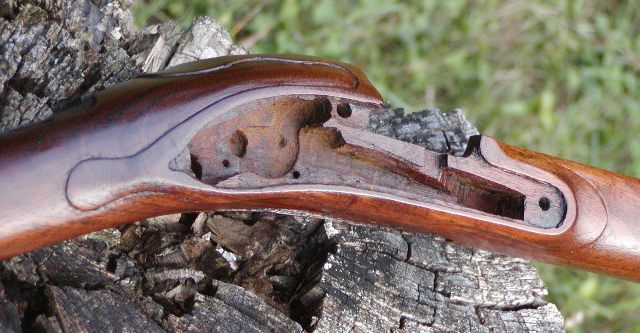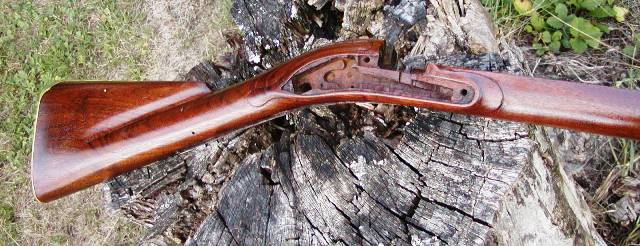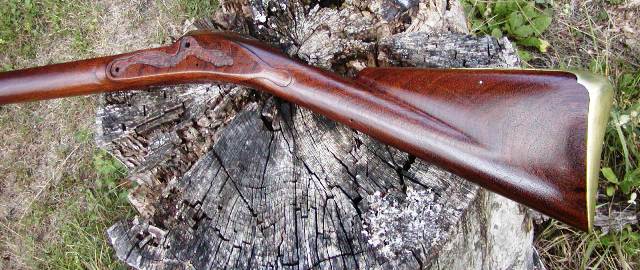- Joined
- May 6, 2014
- Messages
- 17,768
- Reaction score
- 17,058
WOW......DOUBLE WOW......Nope, still not good enough. That Musket deserves an unheard of TRIPLE WOW!!!
OK, I will have to admit this is one of my own personal "Three favorite dream guns from the 18th century."
Having followed Dr. De Witt Bailey's works on British Military weapons and the Brown Bess in particular since the 1970's, I came to know the Pattern 1730 as well as one might without handling one. I loved the Banana Shaped lock and the ornate carving of the lock aprons that flowed down to the bottom side of the stock, but never cared for the early and rather dainty trigger guard nor the fact the lock was single bridled.
British Ordnance did not have much of a chance to do "R & D" on this musket when they began production and first re-armed the entire British Army worldwide with the musket. They found the dainty "Dutch Style" trigger guard did not stand up well on active service while in the process of re-arming the entire Army. So in 1740, they began "upgrading" the P 1730 Musket on then new production Muskets. Each had at least two, if not all three of the upgrades of 1. The more robust trigger guard, 2. The Double Bridle Lock and 3. Plainer Apron Carvings around the Breech Plug and Lock. But they continued to leave a plain rounded end on the front of the fore stock, which they did not correct until they added a nose cap on the P1748 Musket.
Much to my personal regret, P 1748 Muskets were not issued to the American Colonies during the FIW and if any at all actually made it to America, it wasn't until the AWI.
Since I admire the early P1740 wrap around lock aprons, the P1740 with that feature, the double bridle lock and the more robust trigger guard; the P1740 was much more to my liking than the original P 1730 or P 1742.
Sheet brass was sent with the parts and supplies for Artificers (Military Armorers) to make and fit nose bands to muskets in the FIW and the AWI, as they had not had a chance to re-fit nose caps to all earlier Pattern Muskets. However, from the ones I've seen in books and a couple of originals, none were fitted as nicely as Dave has done on this musket.
I ken Dave's musket is a Braw, Braw Lassie of a Brown Bess.
Oh, I've never been able to work the trigger on a repro Brown Bess to get it down much below 4 pounds trigger pull weight and still have the lock function correctly and not have the sear nose occasionally catch on the half cock notch. Now I could not change the position of the trigger pin in the stock to get a little less trigger pull weight. Is that how you got the trigger pull down to about 3 pounds, Dave?
Gus
OK, I will have to admit this is one of my own personal "Three favorite dream guns from the 18th century."
Having followed Dr. De Witt Bailey's works on British Military weapons and the Brown Bess in particular since the 1970's, I came to know the Pattern 1730 as well as one might without handling one. I loved the Banana Shaped lock and the ornate carving of the lock aprons that flowed down to the bottom side of the stock, but never cared for the early and rather dainty trigger guard nor the fact the lock was single bridled.
British Ordnance did not have much of a chance to do "R & D" on this musket when they began production and first re-armed the entire British Army worldwide with the musket. They found the dainty "Dutch Style" trigger guard did not stand up well on active service while in the process of re-arming the entire Army. So in 1740, they began "upgrading" the P 1730 Musket on then new production Muskets. Each had at least two, if not all three of the upgrades of 1. The more robust trigger guard, 2. The Double Bridle Lock and 3. Plainer Apron Carvings around the Breech Plug and Lock. But they continued to leave a plain rounded end on the front of the fore stock, which they did not correct until they added a nose cap on the P1748 Musket.
Much to my personal regret, P 1748 Muskets were not issued to the American Colonies during the FIW and if any at all actually made it to America, it wasn't until the AWI.
Since I admire the early P1740 wrap around lock aprons, the P1740 with that feature, the double bridle lock and the more robust trigger guard; the P1740 was much more to my liking than the original P 1730 or P 1742.
Sheet brass was sent with the parts and supplies for Artificers (Military Armorers) to make and fit nose bands to muskets in the FIW and the AWI, as they had not had a chance to re-fit nose caps to all earlier Pattern Muskets. However, from the ones I've seen in books and a couple of originals, none were fitted as nicely as Dave has done on this musket.
I ken Dave's musket is a Braw, Braw Lassie of a Brown Bess.
Oh, I've never been able to work the trigger on a repro Brown Bess to get it down much below 4 pounds trigger pull weight and still have the lock function correctly and not have the sear nose occasionally catch on the half cock notch. Now I could not change the position of the trigger pin in the stock to get a little less trigger pull weight. Is that how you got the trigger pull down to about 3 pounds, Dave?
Gus









